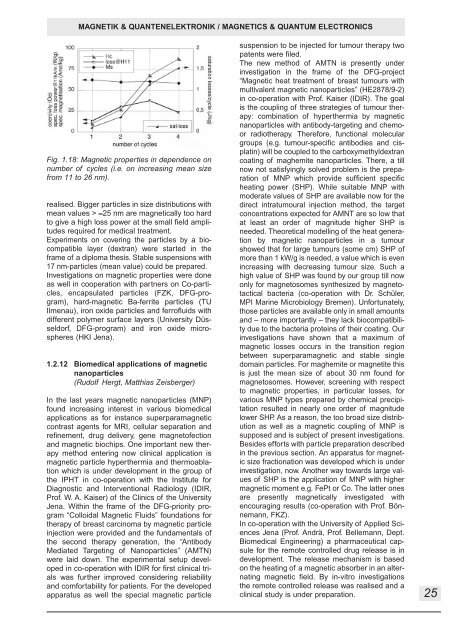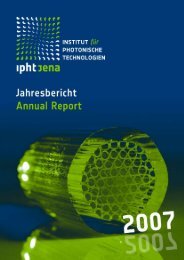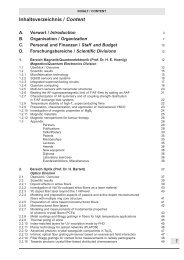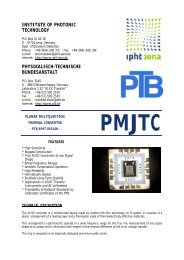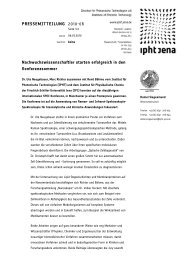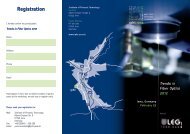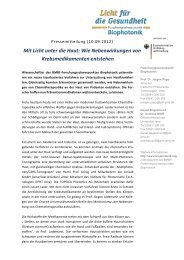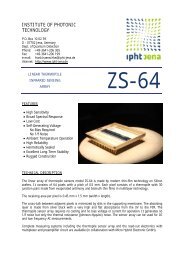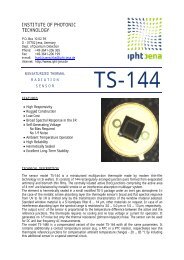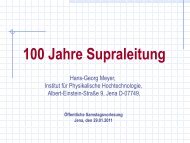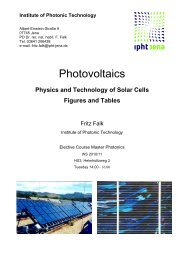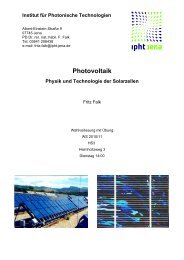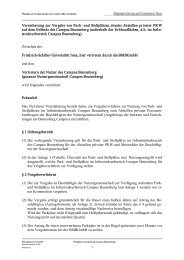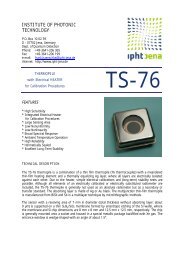Jahresbericht 2005 - IPHT Jena
Jahresbericht 2005 - IPHT Jena
Jahresbericht 2005 - IPHT Jena
Create successful ePaper yourself
Turn your PDF publications into a flip-book with our unique Google optimized e-Paper software.
MAGNETIK & QUANTENELEKTRONIK / MAGNETICS & QUANTUM ELECTRONICS<br />
Fig. 1.18: Magnetic properties in dependence on<br />
number of cycles (i.e. on increasing mean size<br />
from 11 to 26 nm).<br />
realised. Bigger particles in size distributions with<br />
mean values > ≈25 nm are magnetically too hard<br />
to give a high loss power at the small field amplitudes<br />
required for medical treatment.<br />
Experiments on covering the particles by a biocompatible<br />
layer (dextran) were started in the<br />
frame of a diploma thesis. Stable suspensions with<br />
17 nm-particles (mean value) could be prepared.<br />
Investigations on magnetic properties were done<br />
as well in cooperation with partners on Co-particles,<br />
encapsulated particles (FZK, DFG-program),<br />
hard-magnetic Ba-ferrite particles (TU<br />
Ilmenau), iron oxide particles and ferrofluids with<br />
different polymer surface layers (University Düsseldorf,<br />
DFG-program) and iron oxide microspheres<br />
(HKI <strong>Jena</strong>).<br />
1.2.12 Biomedical applications of magnetic<br />
nanoparticles<br />
(Rudolf Hergt, Matthias Zeisberger)<br />
In the last years magnetic nanoparticles (MNP)<br />
found increasing interest in various biomedical<br />
applications as for instance superparamagnetic<br />
contrast agents for MRI, cellular separation and<br />
refinement, drug delivery, gene magnetofection<br />
and magnetic biochips. One important new therapy<br />
method entering now clinical application is<br />
magnetic particle hyperthermia and thermoablation<br />
which is under development in the group of<br />
the <strong>IPHT</strong> in co-operation with the Institute for<br />
Diagnostic and Interventional Radiology (IDIR,<br />
Prof. W. A. Kaiser) of the Clinics of the University<br />
<strong>Jena</strong>. Within the frame of the DFG-priority program<br />
“Colloidal Magnetic Fluids” foundations for<br />
therapy of breast carcinoma by magnetic particle<br />
injection were provided and the fundamentals of<br />
the second therapy generation, the “Antibody<br />
Mediated Targeting of Nanoparticles” (AMTN)<br />
were laid down. The experimental setup developed<br />
in co-operation with IDIR for first clinical trials<br />
was further improved considering reliability<br />
and comfortability for patients. For the developed<br />
apparatus as well the special magnetic particle<br />
suspension to be injected for tumour therapy two<br />
patents were filed.<br />
The new method of AMTN is presently under<br />
investigation in the frame of the DFG-project<br />
“Magnetic heat treatment of breast tumours with<br />
multivalent magnetic nanoparticles” (HE2878/9-2)<br />
in co-operation with Prof. Kaiser (IDIR). The goal<br />
is the coupling of three strategies of tumour therapy:<br />
combination of hyperthermia by magnetic<br />
nanoparticles with antibody-targeting and chemoor<br />
radiotherapy. Therefore, functional molecular<br />
groups (e.g. tumour-specific antibodies and cisplatin)<br />
will be coupled to the carboxymethyldextran<br />
coating of maghemite nanoparticles. There, a till<br />
now not satisfyingly solved problem is the preparation<br />
of MNP which provide sufficient specific<br />
heating power (SHP). While suitable MNP with<br />
moderate values of SHP are available now for the<br />
direct intratumoural injection method, the target<br />
concentrations expected for AMNT are so low that<br />
at least an order of magnitude higher SHP is<br />
needed. Theoretical modelling of the heat generation<br />
by magnetic nanoparticles in a tumour<br />
showed that for large tumours (some cm) SHP of<br />
more than 1 kW/g is needed, a value which is even<br />
increasing with decreasing tumour size. Such a<br />
high value of SHP was found by our group till now<br />
only for magnetosomes synthesized by magnetotactical<br />
bacteria (co-operation with Dr. Schüler,<br />
MPI Marine Microbiology Bremen). Unfortunately,<br />
those particles are available only in small amounts<br />
and – more importantly – they lack biocompatibility<br />
due to the bacteria proteins of their coating. Our<br />
investigations have shown that a maximum of<br />
magnetic losses occurs in the transition region<br />
between superparamagnetic and stable single<br />
domain particles. For maghemite or magnetite this<br />
is just the mean size of about 30 nm found for<br />
magnetosomes. However, screening with respect<br />
to magnetic properties, in particular losses, for<br />
various MNP types prepared by chemical precipitation<br />
resulted in nearly one order of magnitude<br />
lower SHP. As a reason, the too broad size distribution<br />
as well as a magnetic coupling of MNP is<br />
supposed and is subject of present investigations.<br />
Besides efforts with particle preparation described<br />
in the previous section. An apparatus for magnetic<br />
size fractionation was developed which is under<br />
investigation, now. Another way towards large values<br />
of SHP is the application of MNP with higher<br />
magnetic moment e.g. FePt or Co. The latter ones<br />
are presently magnetically investigated with<br />
encouraging results (co-operation with Prof. Bönnemann,<br />
FKZ).<br />
In co-operation with the University of Applied Sciences<br />
<strong>Jena</strong> (Prof. Andrä, Prof. Bellemann, Dept.<br />
Biomedical Engineering) a pharmaceutical capsule<br />
for the remote controlled drug release is in<br />
development. The release mechanism is based<br />
on the heating of a magnetic absorber in an alternating<br />
magnetic field. By in-vitro investigations<br />
the remote controlled release was realised and a<br />
clinical study is under preparation.<br />
25


